







Costa Rica is a safe and welcoming eco-tourism destination that offers adventure, cultural, and service opportunities, but travelers must prepare with proper documents, safety awareness, and health considerations. Rustic Pathways offers organized student travel programs in Costa Rica that combine outdoor adventure, cultural immersion, and community service with strong safety and support systems.
| Passport Requirements | Best Time to Visit | Currency | Safety Level |
|---|---|---|---|
| Valid passport required, valid for the length of stay. | Dry season: Dec – Apr; Wet season: May – Nov. | Costa Rican Colón (CRC); USD widely accepted. | Exercise caution; U.S. State Dept. Level 2 advisory. |
| Entry Requirements | Emergency Services | Money Tips | Beach Safety |
| Return ticket, proof of funds ($100/month of stay). | Dial 911 for emergency services. Medical care available in major cities. | Exchange at banks, avoid airport kiosks; carry small bills. | Be cautious of rip currents; swim at lifeguarded beaches. |
I spent a fair amount of time looking at a map while planning a Central American trip. I wanted to understand the geography before traveling to Costa Rica. My family had to decide what places we wanted to, activities we wanted to do and foods we wanted to taste.
This involved a lot of research. I looked at many online sites, ordered books and talked to people I knew who had been to Costa Rica. Certainly travel experts can make this process much easier.
Organized travel programs take away the guesswork. When you book these trips, people from Costa Rica and those with country expertise make the plans. Still, it’s helpful to know some basic facts before you board the plane to visit Costa Rica.
Key Takeaways:
Costa Rica is located in Central America between Panama to the south and Nicaragua to the north. The Caribbean Sea is east of the country and the Pacific Ocean is west.
Costa Rica is slightly smaller than the U.S. state of West Virginia. Its land is only about 170 miles across at its widest point, and its length is about 288 miles. Overall, Costa Rica has about 762 miles of coastline. That alone makes its “rich coast ” name appropriate.
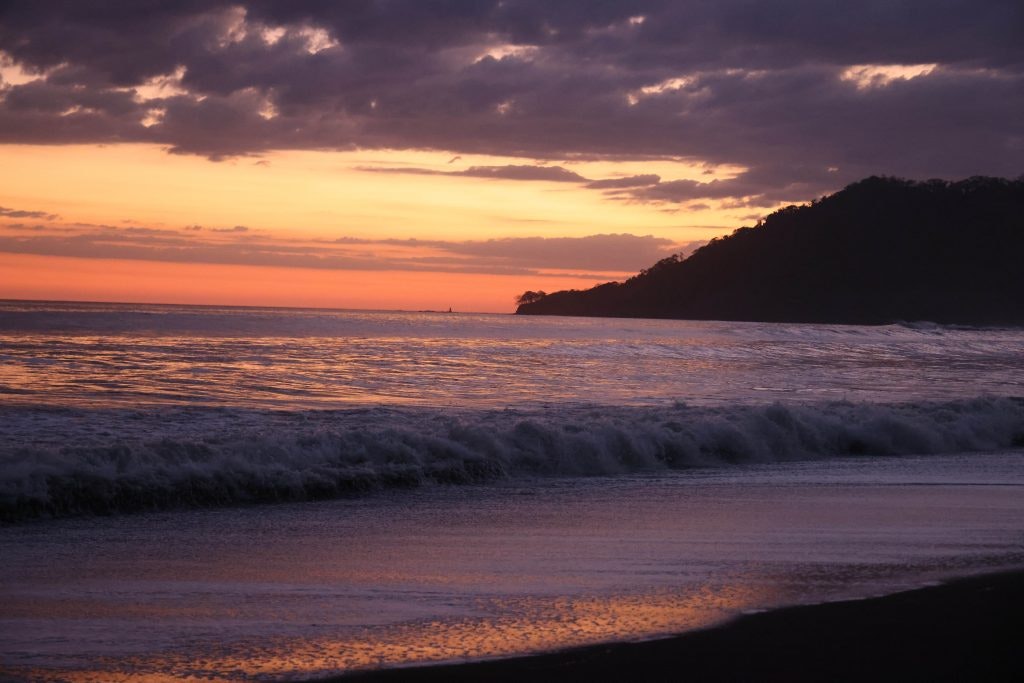
Costa Rica has beautiful beaches.
Costa Rica has about 79 islands, but most of them are in a conservation zone. This limits the number of visitors. Cocos Island is one example. Less than 1500 people are allowed to visit the island each year. And getting there is a chore. The boat ride from the mainland to the island is 36 hours long, and the cost for that journey can be quite high.
Mainland hot spots are much easier to access and are abundant. Costa Rica has hundreds of beaches and picturesque rainforest and mountain areas.
The nation is located on the Caribbean Plate, and its interaction with the Cocos Plate in the Pacific Ocean led to the formation of a number of volcanoes. The Talamanca Mountain Range divides the country. And popular visitor destinations include La Fortuna near Arenal Volcano.
| Requirement | Details |
|---|---|
| Passport | Must be valid for the duration of your stay. Entry may be denied if the passport is damaged. |
| Visa | U.S. citizens do not need a visa for stays of up to 180 days. Immigration authorities will determine your permitted length of stay. |
| Return/Onward Ticket | Proof of onward travel is required. Many airlines require travelers to have a round-trip ticket before boarding. |
| Proof of Funds | Travelers must show proof of at least $100 USD per month of their stay. |
| Yellow Fever Vaccination | Required for travelers arriving from certain South American or African countries. |
| Entry Stamp | Travelers must obtain an entry stamp from immigration officials upon entry. |
| Airport Departure Tax | $29 USD. Check if included in your ticket price or pay upon arrival/departure. |
| Exit for Minors | Non-Costa Rican minor children must have an exit permit from immigration authorities. Minors with dual citizenship need written parental consent. |
| Identification | Carry copies of your passport and immigration documents at all times. |
| Financial Obligations | Unsettled debts, such as unpaid medical bills or child support, can prevent departure. |
U.S. citizens can stay in Costa Rica for up to 180 days without a visa. The immigration officer will determine the permitted length of stay upon entry. Travelers must have a passport valid for the duration of their stay, and any passport damage may result in denied entry. Travelers are required to obtain an entry stamp from immigration officials upon entry, and they should carry a copy of identification and immigration status at all times.
Travelers with unpaid debts to the Costa Rican government, such as medical bills, unpaid child support, or vehicle injury claims, may be prevented from leaving Costa Rica. Make sure to settle any outstanding financial obligations before departure.
Visitors must pay a $29 USD departure tax before leaving Costa Rica. Some airlines include this fee in their ticket price, so check ahead. Paying the departure tax upon arrival or in advance can help avoid long lines at the airport.
Make sure your health insurance includes coverage overseas, as most hospitals do not accept U.S. health insurance, and Medicare/Medicaid is not applicable. We strongly recommend purchasing supplemental insurance that covers medical evacuation, which can be costly and must often be paid upfront.
Costa Rica is generally safe to visit, though caution is advised in certain areas. The U.S. Department of State has issued a Level 2 Travel Advisory, urging travelers to exercise increased caution due to crime.
Common crimes in tourist areas include theft and pickpocketing, while more violent crimes, such as armed robbery and sexual assault, can occur. To stay safe:
In the event of a car accident, be aware that local legal processes can be lengthy, and individuals may be prevented from leaving the country until all injury claims are resolved.
The U.S. Embassy in San José can help with medical care, contacting relatives, and replacing stolen passports. A police report is required for follow-up and insurance claims.
Many Costa Rican beaches have dangerous rip currents, and lifeguards may be absent. To stay safe:
For more on rip currents, visit the NOAA Rip Current Safety page.
Costa Rica is popular for adventure sports, but not all operators meet international safety standards. Guidelines for safety include:
Costa Rica is an active earthquake and volcanic zone. Guidelines for natural disaster preparedness:
For up-to-date information, refer to the U.S. Embassy Costa Rica website, the Costa Rican National Emergency Commission, or the Costa Rican Volcanic and Seismic Observatory.
| Category | Tips |
|---|---|
| Transportation |
|
| Health Precautions |
|
| Petty Crime Prevention |
|
Costa Rica remains a popular and generally safe travel destination if you exercise caution and stay informed. Check for updates from local authorities before traveling.
Travelers to Costa Rica should be up-to-date on all vaccinations recommended by the U.S. Centers for Disease Control and Prevention (CDC). Proof of yellow fever vaccination is required for travelers arriving from countries with risk of yellow fever transmission.
Travelers visiting certain areas may need prescription medication to prevent malaria. Mosquito-borne illnesses, including Dengue, Zika, and chikungunya, are present throughout the country. Rabies exposure can occur if bitten or scratched by an animal. Tap water in some areas, especially rural and national parks, may not be potable—consider using a reusable water bottle and drinking bottled water.
For emergency services in Costa Rica, dial 911. Costa Rica offers good quality medical treatment, including private clinics and hospitals, but be prepared for the costs and the need for upfront payment. Medical care in San José is generally adequate, but outside urban areas, services can be limited, and ambulances may lack necessary equipment. Most prescription and over-the-counter medications are available locally, but it is recommended to bring your own medications in original packaging with a doctor’s prescription. Ensure your health insurance provides overseas coverage, and consider supplemental insurance for medical evacuation, as U.S. Medicare/Medicaid does not apply abroad.
Travelers’ diarrhea is a common health issue; take appropriate precautions with food and water. Staying informed and prepared will help ensure a healthy and enjoyable visit to Costa Rica.
The best time to visit Costa Rica depends on your preferences for weather and activities. The dry season runs from December to April in most regions, making it ideal for outdoor adventures and beach days. The rainy season (also known as the wet season) extends from May to November, bringing lush green landscapes and fewer crowds. The Caribbean region experiences more evenly distributed rainfall, with the best weather often found in March-April and September-October.
| Region | Dry Season | Rainy Season | Weather Facts |
|---|---|---|---|
| Central Valley | December to April | May to November | Mild climate with warm days and cooler nights. |
| Guanacaste | December to April | May to November | Hottest and driest region. |
| Nicoya Peninsula | December to April | May to November | Warm and dry, similar to Guanacaste. |
| Central Pacific | December to April | May to November | Warm and humid, with afternoon showers from May. |
| South Pacific | January to April | May to December | One of the wettest regions with heavy rain from May to December. |
| Caribbean | March-April, September-October | November-February, May-August | More evenly distributed rain; best weather in March-April and September-October. |
| Average | Jan | Feb | Mar | Apr | May | Jun | Jul | Aug | Sep | Oct | Nov | Dec |
|---|---|---|---|---|---|---|---|---|---|---|---|---|
| High | 88°F | 87°F | 87°F | 83°F | 77°F | 74°F | 75°F | 79°F | 83°F | 85°F | 87°F | 88°F |
| Temp. | 79°F | 78°F | 77°F | 73°F | 66°F | 63°F | 62°F | 66°F | 69°F | 74°F | 76°F | 78°F |
| Low | 70°F | 70°F | 68°F | 64°F | 57°F | 54°F | 53°F | 55°F | 59°F | 64°F | 67°F | 69°F |
| Rainfall | Jan | Feb | Mar | Apr | May | Jun | Jul | Aug | Sep | Oct | Nov | Dec |
|---|---|---|---|---|---|---|---|---|---|---|---|---|
| Rainfall (inches) | 5.4″ | 5.3″ | 4.2″ | 4.6″ | 4.9″ | 3.4″ | 2.1″ | 2.4″ | 4.2″ | 6.4″ | 6.2″ | 6.0″ |
| Rainy Days | 16.7d | 15.8d | 12.9d | 10.2d | 10.0d | 7.8d | 6.3d | 6.2d | 8.8d | 13.6d | 12.9d | 15.4d |
Read more: What you need to know about packing for weather overseas
The official currency of Costa Rica is the Costa Rican colón (CRC), named after Christopher Columbus (Cristóbal Colón). Bills come in denominations of 1,000 to 50,000 colones, while coins range from 5 to 500 colones. Each bill features colorful designs depicting some of Costa Rica’s iconic animals, such as sharks, sloths, and butterflies. For the most current exchange rates, check the Central Bank of Costa Rica’s website.
The exchange rate between the colón and U.S. dollar fluctuates; currently, it is around 612 colones to 1 USD. A quick reference is to double the first number of the colón to approximate its value in dollars (e.g., 1,000 colones is roughly $2 USD). U.S. dollars are widely accepted in Costa Rica, but it’s best to bring smaller bills ($1, $5, $10, and $20) in good condition. Most places will provide change in colones, and larger bills like $50 or $100 are harder to use, often requiring an exchange at a local bank.
When using public transportation or hiring taxi drivers, it is advisable to carry smaller bills or coins for easier transactions. Official taxis in Costa Rica are red with a yellow triangle and accept colones. Paying with exact change helps avoid overcharges.
Costa Rica is in the Central Time Zone (GMT-6). The country does not change its time based on seasons like most regions of the United States. For that reason, Costa Rica will be one hour behind cities like New York during standard time. But it’s two hours behind during daylight savings time that runs from mid-March to early November.
For the west coast of the United States, Costa Rica will be two hours ahead during standard time. And the country will be one hour ahead during daylight savings time.
Where you go in Costa Rica depends on your travel time and your interests. There are several common destinations. In the north, La Fortuna in the Arenal Volcano region and Monteverde Cloud Forest are great choices. These areas are teeming with wildlife and have picturesque mountain views.
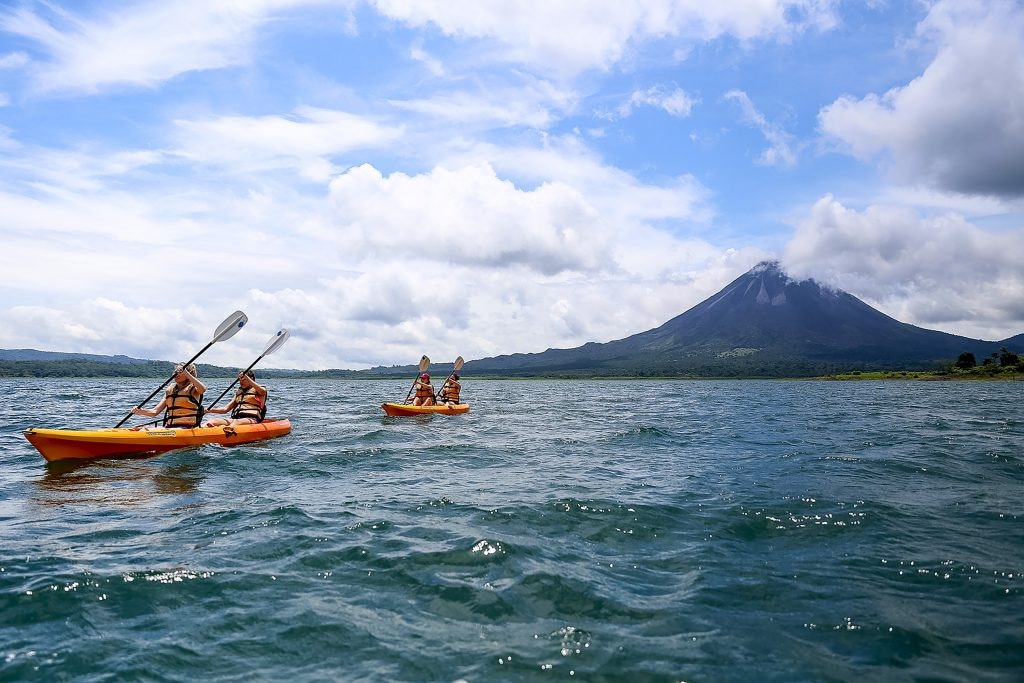
Rustic Pathways students kayak in beautiful Lake Arenal right at the foot of the volcano. Copyright: © 2015 Rustic Pathways
To the northwest, travelers often visit the Nicoya Peninsula. This is a well-known destination for surfers and beach lovers. There are also nature preserves like the Camaronal Wildlife Refuge that protect endangered sea turtles.
Farther south, Manuel Antonio National Park on the Pacific coast is one of the country’s most popular destinations. It’s the nation’s smallest national park, but the area is renowned for its beautiful beaches and wildlife. This includes sloths, howler monkeys and many species of birds. While in the region, travelers can search for animals and take in the views while hiking on easy trails.
Less commonly visited spots include the Osa Peninsula in southern Costa Rica and parts of the Caribbean coast. The Osa Peninsula has areas of untouched scenery that can give travelers a more remote jungle experience. Corcovado National Park is just one of the places you can check out while in this area.
The Caribbean coast has traditionally been a more popular destination for Europeans than travelers from countries like the United States. Along the coast there are places with more of a Caribbean vibe. Scenic destinations include Cahuita National Park and the town of Puerto Viejo de Talamanca in the southeast.
One possible note of caution is that the port city of Limon has a higher crime rate. It’s located almost directly east of San Jose on the Caribbean coast. During my family trip, it was the one spot where we felt we needed to be more cautious when we traveled through.
This city is not a popular destination for travelers. And there are a few other spots like this in the country. This includes the León XIII, Tibás neighborhood in the northern part of San José and an agricultural region bordering Nicaragua. These are areas where travelers are unlikely to go. Overall, Costa Rica is known for its safety, which is a key reason it’s a popular travel destination.
In Costa Rica there are many activities to try including adventure activities, cultural activities and service activities.
It is the perfect travel destination for adventure seekers and with opportunities for cultural immersion and the chance to give back to the local communities, it’s tough to go wrong with a trip to Costa Rica.
On the adventure front, popular activities include ziplining, white water rafting, rappelling and surfing. Ziplining is available in many regions of Costa Rica. The nation is known for canopy tours that allow you to fly above rainforests and waterways. The highest zipline in the country is in the Arenal Volcano area. It reaches a height of 656 feet, which is higher than the country’s tallest building.
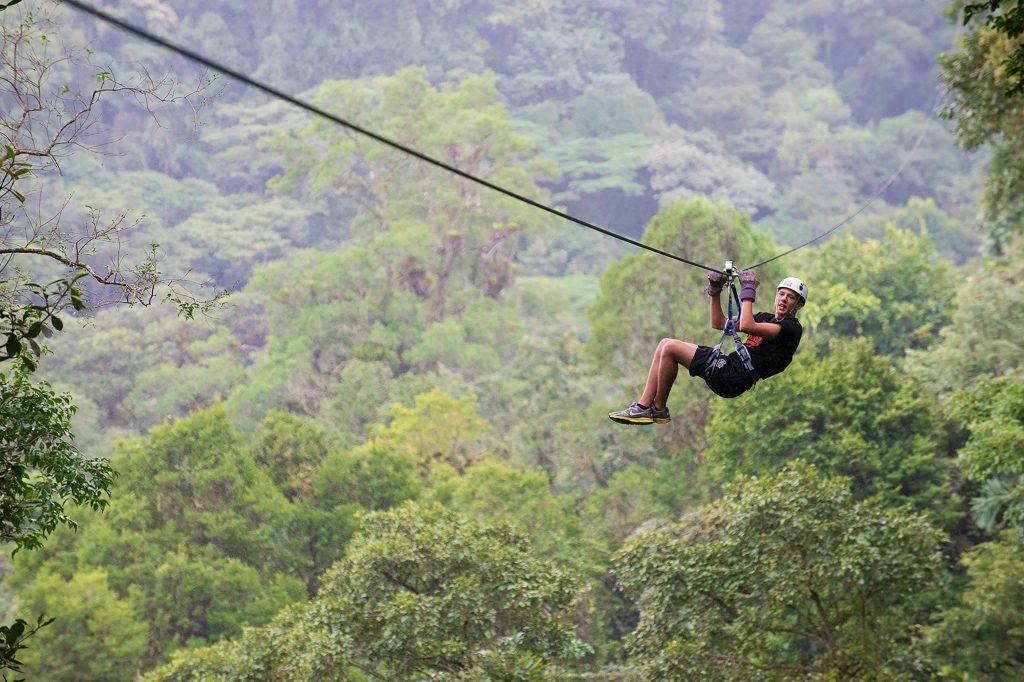
A Rustic Pathways student zip lines through the rainforest canopy near Arenal Volcano. Copyright: © 2013 Rustic Pathways
There are zipline systems that will take you across miles of landscapes so you can see a diversity of flora. If you want to be more cautious, many regions also have smaller ziplines, so you don’t have to challenge your bravery as much.
For white water rafting, the Pacuare River is one of the best rafting locations in the world. It has thrilling class IV rapids. Plus, the river is clean and is set amid some beautiful scenery.
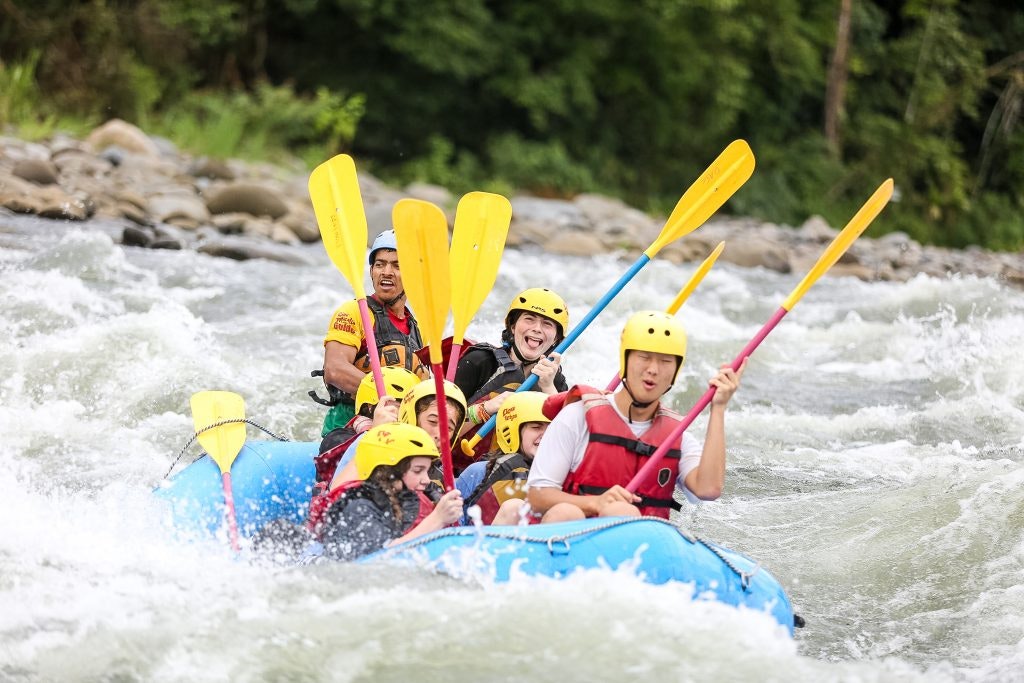
Rustic Pathways students enjoy white water rafting while on the Pura Vida Service program. Copyright: © 2016 Rustic Pathways
Like ziplining, different levels of white water rafting are available depending on your preference. You can select rafting rides called safari floats that take you on mild Class I and II rapids. One option for this is Rio Balsa near Arenal Volcano.
On the other end of the spectrum, the El Chorro section of the Naranjo River has Class V sections. It’s located east of Manuel Antonio. Children under 12 are not allowed in this section. It’s geared towards people with white water experience who are prepared for advanced runs through narrow and steep canyons.
Speaking of canyons, canyoning and waterfall rappelling is also an option in the Arenal Volcano area, along with numerous other locations like Manuel Antonio National Park. In these activities, your goal is to get down a steep cliff often using ropes
For surfing, Costa Rica is considered a world-class destination. Some of the best beaches for catching a wave are off the coast of the Nicoya Peninsula in Guanacaste Province. This includes places like Playa Avellanas that’s also known as Little Hawaii. On this beach, the waves tend to be in the two to four-foot range, making it a perfect spot for people at different surfing ability levels.

Hone your surf skills alongside fellow travelers. Copyright: © 2016 Rustic Pathways
In addition to these adrenaline-pumping activities, most people take the time to hike while in Costa Rica. A walk through the rainforest provides the best opportunities to see wildlife like those adorable sloths. Plus, there are many parks with added areas of interest, such as volcanic rocks and hanging bridges.
Cultural opportunities are also abundant in Costa Rica. If you’re lucky, you can enjoy a cultural music and dance performance and then try some of your own dance steps. This type of activity is easier to experience on a student travel program like Pura Vida Service.
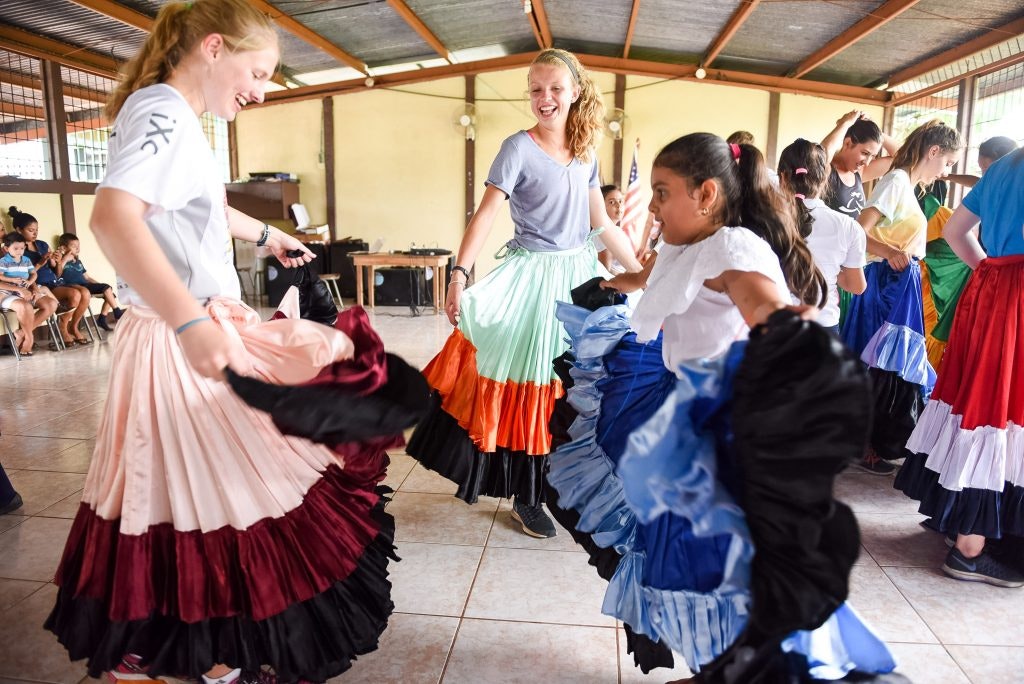
Try some dance moves in Costa Rica. Copyright: © 2016 Rustic Pathways
Many other cultural activities center around food. You can tour chocolate and coffee farms where you’ll learn how these important products are made.
Coffee is one of the nation’s top exports, and both items are treasured parts of the culture. During a tour you can see how the beans are grown and then transformed into consumable products. You also can do your share of taste testing!
Eating locally grown food is a big part of the cultural experience in Costa Rica. Aside from chocolate, you’ll want to try the many tropical fruits in the country, along with traditional rice and bean dishes. These dishes include gallo pinto and casado.
Gallo pinto is a rice and bean dish often served with a slightly sweet and spicy lizano sauce. An egg may be added for breakfast. Casado often includes rice, black beans, plantains, salad, a tortilla, and an optional protein source such as chicken or beef.
After you’re full, you can go shopping for locally made crafts. This might include small replicas of traditional ox carts, jewelry, and various fabric items, including clothes and handbags.
If you’re interested in service, signing up for a travel program is your best bet. Nonprofits like the Rustic Pathways Foundation have deep ties to the local Costa Rican communities and work with residents to coordinate projects.
Initiatives include infrastructure projects at schools, environmental work at national parks and animal conservation initiatives at wildlife refuges.
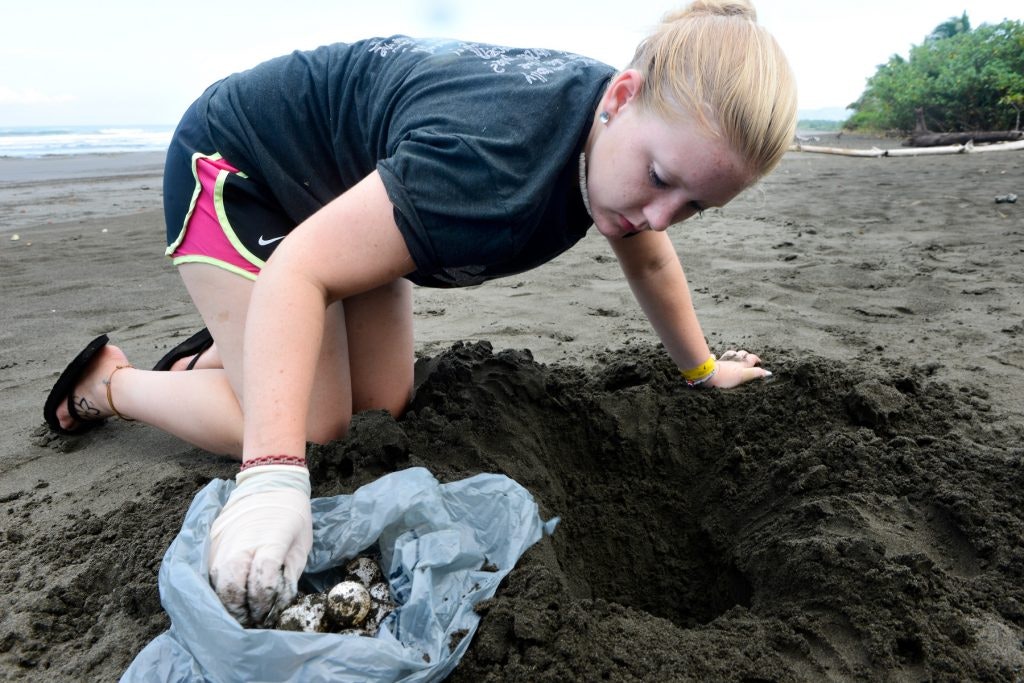
A Rustic Pathways student gathers sea turtle eggs to save them from poachers in Costa Rica.
In 2023, Rustic Pathways students provided more than 15,700 hours of community service in Costa Rica. The tasks they tackled included:
Check out the video below for a beginner’s travel guide to Costa Rica or contact us with questions about traveling to Costa Rica!
Yes! Costa Rica is considered one of the safest countries in Central America, especially for travelers. It has a stable government, low crime rates in tourist areas, and a strong focus on welcoming international visitors.
Costa Rica has two seasons: the dry season (December to April) and the green (rainy) season (May to November). The dry season is ideal for beach and outdoor adventures, while the green season offers lush landscapes and fewer tourists.
Costa Rica is perfect for outdoor adventure and eco-tourism. Visitors can go ziplining, surfing, whitewater rafting, hiking in rainforests, seeing volcanoes, visiting wildlife sanctuaries, and volunteering in conservation programs.
Not necessarily. While Spanish is the official language, many people in the tourism industry speak English. Learning a few Spanish phrases can enhance your experience, but it’s not required to get around.